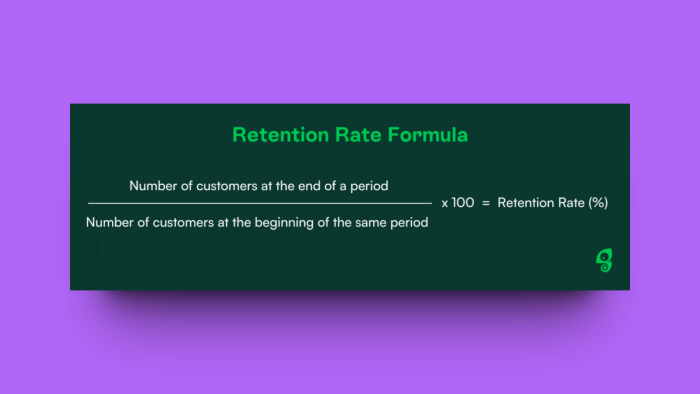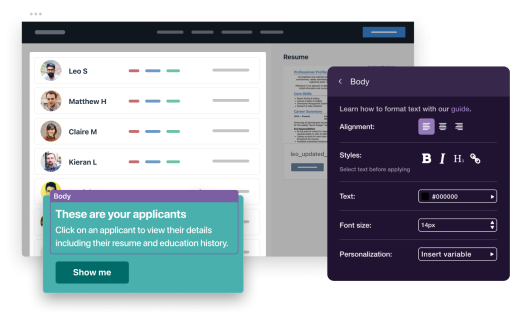Getting people to sign up for your product is about getting your foot in the door. Real success (and revenue) lies in guiding users to internalize your product's value and deepen their engagement. This will naturally ramp up your user adoption rate and build customer loyalty. That's not just us saying it, product leaders all agree that metrics are key to measuring success:
Here’s the catch: you have to constantly analyze and optimize the user experience to reduce time-to-value for new users, eliminate friction, and increase product usage. If you want to begin tracking product adoption metrics that matter, read on.
What are product adoption metrics?
Product adoption metrics are measures that identify how sticky a product is and how successful it is at delivering value to the user.
How do you calculate adoption metrics?
Calculating each product adoption metric is specific to what the metric is.
For instance, the activation rate is the number of users who reach the milestone divided by the total number of users who signed up, whereas Time-to-Value is calculated by the duration between signup and completion of the milestone.
What is an example of a product adoption rate?
Some of these metrics are activation rate, engagement score, and feature adoption rate. Read below to find out more.
How do you increase the product adoption rate?
Design a flawless onboarding experience
Create in-app guidance
Engage users via in-app messages
Target specific user personas for feature adoption
Track, analyze, and optimize UX
Read on to learn all about product adoption metrics and best practices to optimize product adoption!
How to calculate product adoption rate
The product adoption rate measures the number/percentage of customers actively using your product and its features. With so many alternative SaaS options available to your target users, it's natural for them to test-drive your product and never use it again.
Measuring your product and feature adoption rate shows a clear picture of how many users:
Sign up and abandon the tool
Apply only a select few features
Proactively use your tool for their needs
Stop using the tool after a certain point
Effectively onboard your tool and love it
You can track product adoption across different timelines—daily, weekly, monthly, quarterly, or annually. And here’s a formula for calculating product adoption.

Now, let’s look at ten other essential product adoption metrics you can track to understand different aspects of user behavior and increase your end goal: more people adopting your product.
10 key product adoption metrics to track
Here are the top most crucial product adoption metrics you should track.
1. Activation rate
Users can feel pretty lost and clueless after signing up for a new app. It’s like driving in a new city without Google Maps to show them around. It can be daunting without your customer success team showing them the lay of the land.
User activation assesses how well you can guide these new users to their "aha!" moment and help them realize your product's real value for their goals. Tracking activation rate clarifies if users gain enough value from your app to include it in their routine workflows.
To measure user activation, you have to create action-based milestones within your app that clearly indicate a user’s activation level.
How to calculate activation rate
Once you have clear milestones, you can take how many people have completed those milestones and divide it by the total users who have started a trial.

2. Time to value (TTV)
New users take time to fully understand a product’s functionality and figure out its value for their goals. Time to value (TTV) calculates this timeline from sign-up to activation.
Now, picture yourself in a restaurant, waiting for your order. The more time it takes, the hungrier you get—and possibly more frustrated. Worst-case scenario, you storm out of the place and leave them a bad review.
This is exactly what you can avoid for your users by tracking time-to-value. TTV allows you to identify adoption bugs in the onboarding process, fix these issues, and set some production adoption benchmarks for you to beat.
How to calculate TTV
When you have the activation milestone, you can simply measure how long it takes for a user to get there.

3. Engagement score
Is your app’s performance “yay” or “nay” from your users’ perspective? Are they delighted or frustrated with the ROI? The engagement score measures your product’s overall user sentiment to answer these questions.
Users with a high engagement score are getting great results from your product, which motivates them to use your app more actively. On the flip side, users with low engagement are disappointed and could be at risk of churning.
The engagement score gives you a pulse of the users’ product sentiment and collects their unsaid reviews of your app. Analyzing highly-engaged users and identifying the reasons behind their deep engagement levels can also boost adoption.
How to calculate engagement score
Track user behavior through a combination of factors that you set as engagement events. These events will depend on your product, user personas, user journeys, and different milestones they reach on their way to product adoption.
For example, these events could be:
Product usage frequency
Key features users engage with
Support tickets submission
A pattern of renewals or upgrades
Assign a value to each engagement event on a scale of 1-10, depending on its importance, and make sure your whole team is aligned on it.
Here’s the engagement score formula, where “w” stands for the engagement event and “n” is the number of times that event occurred. Sum up the scores of all factors to determine the engagement score for every user or customer account.

4. Feature adoption rate
Imagine cooking in someone else’s kitchen and you have no idea where to find the items you need. Sounds chaotic? It happens to us all—well, a lot of us.
New users in your product are in a similar fix. Only when they find all the ingredients and utensils—get a good grip on product features—can they get cooking!
Some users will struggle to find, navigate, and understand certain features, which can increase their time-to-value and push back the activation milestone.
Tracking the feature adoption rate ensures you’re ahead of users to resolve any issues slowing their product usage. Once you identify these friction areas, simplify the user experience with in-app guidance and widgets.
You can measure the adoption rate for:
New features: assess how users adapt to new features
Key features: check users’ preference for your product’s core features
Advanced features: analyze the response to more technical features
How to calculate feature adoption rate
Calculating the feature adoption rate is the same as the product adoption formula, but applied to each feature.

5. Active users
Just like not everyone who buys a gym membership goes to the gym every day, not everyone who signs up for your product will use it every day. However, those who do use it as regularly as every day are called active users.
A product's active users indicate its stickiness. A high number of active users means customers are highly engaged and find value in your app.
Measuring daily active users (DAU) clarifies how many users depend on your product daily, while monthly active users (MAU) show the number of users interacting with your app frequently.
These metrics depend on your product’s purpose and there’s no standard benchmark for good or bad DAU/MAUs. For example, the DAU for an invoicing tool won’t compare to the DAU for a video recording tool. You’ll want to figure this metric goal out for your product and then benchmark it against yourself.
How to calculate active users
You can calculate daily and monthly active users by:
Daily active users = Number of unique daily users over a month / Total number of days in a month
Monthly active users = Number of unique users in every month / 12
And you can use measure the DAU/MAU ratio with this formula.

🦎 Tip: Tracking the right metrics is just the beginning! Check out our guide on digital adoption tools to see how they can help you measure and improve key adoption metrics.
6. Average session duration
Many SaaS products run on a user’s attention span—the more time and attention users spend on these apps, the more value they gain, or so you would think. Like DAUs and MAUs, this metric is unique to the type of product you’re using. The longer average session duration doesn’t always mean the better.
For example, session durations for an image file type conversion app won’t be half the time as session durations for tools that help you edit articles or make presentations.
If your average session durations are ranging at 10 minutes for what should be a 2-minute job, then your product team has got some work to do—your users aren’t able to do their job quickly enough.
Figure out your ideal session duration and then benchmark that against your real average. Are the two lining up? Is your tool being adopted and used how you intended? If it’s not, that churn rate will rise really fast.
How to calculate average session duration
Here’s how you can calculate your average session duration.

7. Product usage frequency
How often does each user open your app to perform an action or complete a task? Measuring the frequency of product usage for individual users is another effective way to increase product adoption.
This metric gives you a list of highly-engaged customers who use your app more than the others. Focus your efforts on these customers to maximize their lifetime value and adoption rates. These users are more likely to become power users and refer new customers in the long run.
How to calculate product usage frequency
Getting usage frequency is figuring out how many users have accessed the product in a given period, then divide that by the total number of users you actually have.

8. Customer satisfaction score
The customer satisfaction (CSAT) score calculates a customer's level of satisfaction with your product. Unlike the customer effort score that measures users’ transactional effort to use your product, CSAT evaluates users' sentiments toward your product and helps improve the user experience.
Tracking satisfaction with CSAT surveys gives you a clear direction for making in-app improvements to drive product adoption. You can use this feedback and customer inputs to increase their satisfaction and build on their in-product experience to bring repeat business. If it’s not broken, don’t fix it, but certainly, improve it!
You can measure CSAT scores with in-product Microsurveys. These are typically one-question surveys with a Likert scale of 1-5, triggered by user action inside your product. This will give you contextual and more accurate feedback.
How to calculate the CSAT score
Once you gather user responses, you can use this formula to calculate your CSAT score:

9. Customer lifetime value
To double down on active customers and increase your product adoption rates, you’ll need to measure every customer’s lifetime value (LTV). It defines the total revenue your business gains from a given customer.
The higher the LTV, the more money you should be willing to part with upfront in order to attract this profile. It also helps you prioritize the customer base that best fits your product and best fills your budget.
How to calculate the customer lifetime value
Your LTV may vary depending on what your offering is, but generally it's the total amount of money they spend over their time with your product minus the cost to acquire the customer.

10. Customer retention rate
The customer retention rate is closely tied to customer lifetime value. It shows how well you can retain customers and expand their lifetime with your product. A strong retention rate creates more opportunities for product expansion and boosts customer loyalty.
Tracking the retention rate can also help you gauge customer satisfaction and take the right steps to enhance it further.
How to calculate customer retention rate
Calculating retention rate is simple. Just take how many customers you have at the end of a given period, divided by how many you had at the start of that period.

👀 Now that you know the right metrics to track product adoption, let’s look at a few best practices to improve adoption and scale your SaaS revenue.
5 actionable tips to increase product adoption
An increasing product adoption rate creates a domino effect to skyrocket your growth with higher usage frequency, deeper engagement, and better retention. How exactly can product teams unlock this kind of success?
Here are our five top tips to increase product adoption and accelerate your success:
1. Design a flawless onboarding experience:
Make a solid first impression and give new users all the reasons to give your product a shot. A seamless user onboarding process includes welcome messages, interactive product walkthroughs, and action-based checklists.
2. Create in-app guidance and interactions:
Reduce the time-to-value and nudge users toward activation with an intuitive interface and handy in-app guidance. Identify friction points where users get stuck and add help widgets and tooltips to shorten the learning curve.
3. Engage users via emails and in-app messages:
Reinforce your ideal user experience through consistent in-product messages shared via emails and within your app. Tell new users about the next steps and re-engage with existing users through interesting use cases for different features that align with their job to be done. Give them behavioral triggers to use your app better.
4. Target specific user personas for feature adoption:
Play it smart with your feature launches by focusing mainly on the best user persona for each feature. Push the feature to this primary segment and increase the appeal of your features, eventually boosting the feature adoption rate as well.
5. Track, analyze, and optimize UX:
Consistently monitor and analyze user behavior to pin down common issues and bottlenecks spoiling your product's UX. Tweak the experience to remove friction and streamline user journeys.
Ramp up product adoption with these metrics
Data is one of the most pivotal factors of success for product-based companies. You need relevant data to understand your users' expectations and make strategic decisions to improve product adoption.
Tracking the correct metrics is a big part of aligning your product with your target audience. So, bookmark this list of 10 must-track metrics to make product adoption a priority for your SaaS.

Leverage Product Adoption to Survive the SaaS Winter
Create experience that delights users and boosts your revenue





